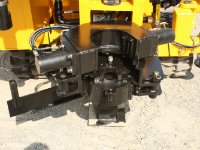Tripping out drill rods can range from being somewhat tedious to seriously dangerous; not to mention it is also hard, physical work. While sharing the same basic principles of water well, geothermal, foundation and other drilling industries, the processes used for tripping the drilling rods in the oil and gas industries are a different animal altogether. Here we will focus on equipment and techniques common to lighter-duty, more mobile, truck- and track-mounted top-drive drilling rigs.
While drilling, the drill string comes under tremendous amounts of torque and friction, which seemingly fuse threaded drill rods together. The challenge is breaking those extremely tight tool joints when retracting the drill string. In addition, heavy tooling and powerful drill heads can pose a serious threat to fingers, hands, heads and even your life if used incorrectly. The same difficulties apply to retrievable threaded casing. Another challenge is preventing the drill string from dropping back down the borehole, which results in costly downtime and expensive fishing tools for retrieval.

|
|
RigKits says their Hands-Free Safety Clamps, even as a retrofit, can increase efficiency and productivity. Source: RigKits |
To simplify the process, and make it faster and safer, most drilling rigs are equipped with clamping/breakout systems. The most basic devices may include manual clamps and hand wrenches that require brute force to break the connection. More sophisticated hydraulic breakout equipment makes the process safer and easier, often requiring only one-man operation. One effective system commonly used is a single set of hydraulic clamps and automatic breakout wrenches. The bottom clamps, sometimes called “clam” clamps because of the clam-like gripping action, grip the bottom drill rod, which both aids in preventing the drill string from dropping down the hole and firmly holds the drill string to allow breaking out. A fixed wrench is used to grip the machined wrench flats on the bottom drill rod, which holds the drill string and prevents it from twisting, while the automatic wrench on top grips the wrench flats on the upper drill rod and, driven by a hydraulic cylinder, breaks the connection. In this system. the wrenches must be aligned on the flats manually so, while increasing safety and efficiency, it is not totally hands-free and there is still a degree of risk to the crew.
Another popular and efficient system is double-breakout clamps. They are made up of two sets of clamps with grip-jaw inserts. The jaws are forced inward by hydraulic cylinders, thereby tightly squeezing the drill string or casings. To break the connection, the bottom clamp grips the lower tool joint and the top clamp grips the upper joint. The bottom clamp holds the drill string firmly in place while the top clamp is twisted by a hydraulic cylinder. The sequence is repeated until all sections of the drill string have been removed. Since the grip jaws can expand and contract to accommodate a wide range of diameters, double breakout clamps are commonly used for tripping out both drill rods and threaded casings.
There is, however, a third type of clamping system. RigKits LLC in North Carolina has developed a hands-free safety clamp. They blend the standard clam clamp system with a bottom rod wrench and a top set of breakout clamps. The Safety Clamps provide an 8.8-inch ID bottom clam clamp, which also doubles as a holder for the rod wiper. It can even grip PVC sewer pipe without damaging it for simple casing installation, as is often used on geothermal drill sites for keeping any unconsolidated boreholes open for grouting, whereafter the PVC casing is removed. In the middle is a rod/auger holding plate to stop the drill string from turning or dropping down the hole. The top clamps grip anything from 2.5-inch OD pipe to 8.8-inch OD casing with a combined gripping force of over 40,000 pounds and a breakout torque of up to 17,000 foot-pounds. The system is totally hands-free, increasing efficiency and safety for the entire drill crew.
Drilling rig manufacturers offer various clamp options with new rigs to accommodate a variety of drilling methods and industries. But, after the initial purchase, our drilling focus or application may change. Thankfully, just like other components on your rig, the clamping system can be upgraded. That’s good news for owners of used equipment, too. A failing, outdated or inadequate clamping system can severely slow production on site, result in costly downtime and possible injury to the crew. Retrofitting a proper clamping system is a good way to increase efficiency, productivity, and above all, safety.
Correction: The photo with this story has been updated to show the correct clamping system. Due to an editing error, we had used a photo showing clamps that were neither hands-free or safety. National Driller regrets the error.
Find Out More
The new Hands-Free Safety Clamps offer the best of both types of clamping systems, but are safer and quicker to use, according to product manufacturer RigKits. They combine the more standard “clam clamp” system that usually requires hand wrenches with a bottom hydraulic-operated rod wrench and a top set of breakout clamps for casings. The top clamps are capable of gripping a 2.5-inch OD pipe to an 8.8-inch OD casing, with a combined gripping force of over 40,000 pounds and a break-out torque of up to 17,000 foot-pounds. Retrofits available. Visit www.rigkits.com for details.




Report Abusive Comment